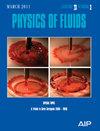Adaptive momentum equation method for overcoming singularities of dispersed phases
IF 4.1
2区 工程技术
Q1 MECHANICS
引用次数: 0
Abstract
The singularity issue arising from the phase fraction approaching zero in multiphase flow can significantly intensify the solution difficulty and lead to nonphysical results. By employing the conservative form of momentum equations in high-phase-fraction and discontinuity regions and the phase-intensive form of momentum equations in low-phase-fraction regions, computational reliability can be assured while avoiding the singularity issue. Regarding the proposed adaptive momentum equation method, the form of momentum equations for each cell is determined by a conversion bound and a phase fraction discontinuity detector. A comparative analysis is conducted on this method and other singularity-free methods. For discontinuities of dispersed phases, an error estimation method of the conversion bound is presented through theoretical analysis. Computational results demonstrate that the discontinuity detector accurately captures discontinuities in high-phase-fraction regions while disregarding pseudo-discontinuities in low-phase-fraction regions. Compared to the conservative form corrected by the terminal velocity method, the method yields higher-quality flow fields and potentially exhibits an efficiency improvement of over 10 times. Compared to the phase-intensive form, the method benefits from the physical quantity conservation, providing higher computational reliability. When encountering discontinuities, the expected error from the error estimation method aligns well with the actual error, indicating its effectiveness. When the conversion bound is below 1/10 000 of the inlet phase fraction, the errors of the adaptive method are essentially negligible.克服分散相奇异性的自适应动量方程法
多相流中相分数趋近于零时产生的奇点问题会大大增加求解难度,并导致非物理结果。通过在高相分数和不连续区域采用保守动量方程形式,在低相分数区域采用相密集动量方程形式,可以在避免奇异性问题的同时保证计算的可靠性。关于所提出的自适应动量方程方法,每个单元的动量方程形式由转换约束和相分数不连续检测器决定。我们对该方法和其他无奇点方法进行了比较分析。对于分散相的不连续性,通过理论分析提出了转换约束的误差估计方法。计算结果证明,不连续性检测器能准确捕捉高相分数区域的不连续性,同时忽略低相分数区域的伪不连续性。与用末端速度法校正的保守形式相比,该方法产生的流场质量更高,效率可能提高 10 倍以上。与相位密集形式相比,该方法得益于物理量守恒,提供了更高的计算可靠性。当遇到不连续性时,误差估计方法的预期误差与实际误差非常吻合,这表明了该方法的有效性。当转换界限低于入口相位分数的 1/10 000 时,自适应方法的误差基本上可以忽略不计。
本文章由计算机程序翻译,如有差异,请以英文原文为准。
求助全文
约1分钟内获得全文
求助全文
来源期刊

Physics of Fluids
物理-力学
CiteScore
6.50
自引率
41.30%
发文量
2063
审稿时长
2.6 months
期刊介绍:
Physics of Fluids (PoF) is a preeminent journal devoted to publishing original theoretical, computational, and experimental contributions to the understanding of the dynamics of gases, liquids, and complex or multiphase fluids. Topics published in PoF are diverse and reflect the most important subjects in fluid dynamics, including, but not limited to:
-Acoustics
-Aerospace and aeronautical flow
-Astrophysical flow
-Biofluid mechanics
-Cavitation and cavitating flows
-Combustion flows
-Complex fluids
-Compressible flow
-Computational fluid dynamics
-Contact lines
-Continuum mechanics
-Convection
-Cryogenic flow
-Droplets
-Electrical and magnetic effects in fluid flow
-Foam, bubble, and film mechanics
-Flow control
-Flow instability and transition
-Flow orientation and anisotropy
-Flows with other transport phenomena
-Flows with complex boundary conditions
-Flow visualization
-Fluid mechanics
-Fluid physical properties
-Fluid–structure interactions
-Free surface flows
-Geophysical flow
-Interfacial flow
-Knudsen flow
-Laminar flow
-Liquid crystals
-Mathematics of fluids
-Micro- and nanofluid mechanics
-Mixing
-Molecular theory
-Nanofluidics
-Particulate, multiphase, and granular flow
-Processing flows
-Relativistic fluid mechanics
-Rotating flows
-Shock wave phenomena
-Soft matter
-Stratified flows
-Supercritical fluids
-Superfluidity
-Thermodynamics of flow systems
-Transonic flow
-Turbulent flow
-Viscous and non-Newtonian flow
-Viscoelasticity
-Vortex dynamics
-Waves
 求助内容:
求助内容: 应助结果提醒方式:
应助结果提醒方式:


